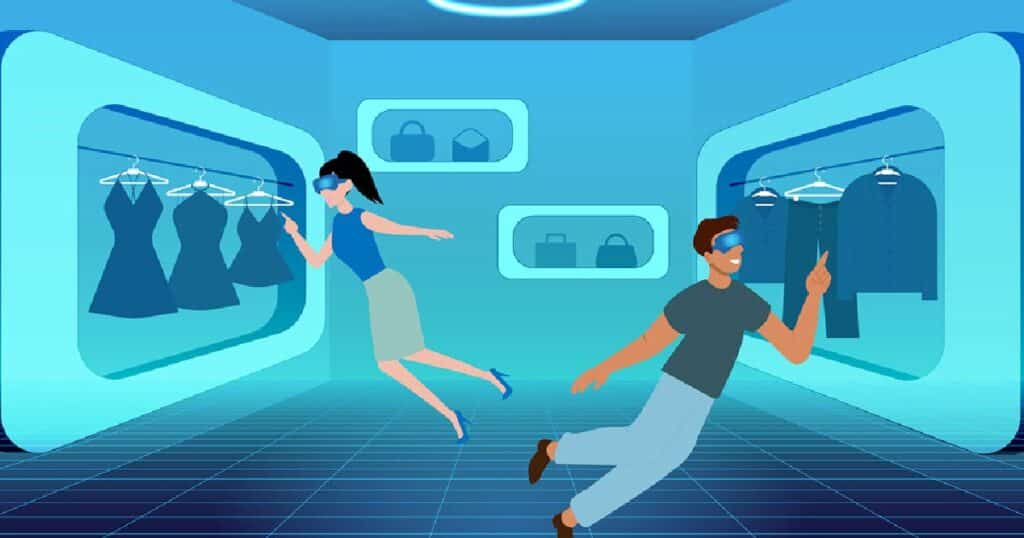The metaverse is a concept that has gained significant attention in recent years, and its impact on various industries, including e-commerce, cannot be understated. In this section, we will explore the rise of the metaverse, its core concepts, the existing e-commerce landscape, and the need for innovation. By the end of this introduction, you will have a glimpse into the transformative potential of the metaverse in reshaping the future of e-commerce.
It can be defined as a virtual realm where users interact with a computer-generated environment, often facilitated through technologies such as virtual reality (VR), augmented reality (AR), and blockchain. It represents a convergence of digital spaces, offering immersive and interactive experiences beyond the constraints of physical reality.
Online shopping has witnessed remarkable growth, enabling consumers to access products and services conveniently from their devices. However, traditional e-commerce has its limitations, such as the lack of personalization, limited sensory experiences, and detached customer interactions. The metaverse presents an opportunity to overcome these challenges and provide a paradigm shift in the way people engage in online commerce.
In the following article, we will delve deeper into how the metaverse will revolutionize e-commerce forever. We will explore its impact on personalized shopping experiences, the integration of AR and VR, the role of blockchain and cryptocurrency, and the future possibilities that lie ahead. Get ready to embark on a journey into the exciting realm of the metaverse and its transformative potential for e-commerce.
Understanding the Metaverse

It is an evolving concept that refers to a virtual, interconnected space where people can interact with digital environments, objects, and other users in real-time. It is often described as a collective virtual shared space that encompasses multiple digital platforms, technologies, and experiences. While the concept of the metaverse has gained popularity in recent years, its origins can be traced back to science fiction literature and early virtual reality experiments.
The term “metaverse” was coined by Neal Stephenson in his 1992 science fiction novel, “Snow Crash.” In the book, it was portrayed as a massive virtual reality-based successor to the internet, where users could engage in various activities and experiences. Since then, the concept has captured the imagination of technologists, futurists, and entrepreneurs who envision a future where it will becomes an integral part of our digital lives.
It is composed of several key components, including virtual reality (VR), augmented reality (AR), and blockchain technology. VR allows users to immerse themselves in a simulated digital environment through headsets or other devices, creating a sense of presence and interaction. AR, on the other hand, overlays digital information onto the real world, enhancing the user’s perception and interaction with their physical surroundings. Blockchain technology, known for its decentralized and secure nature, can facilitate the creation and management of virtual assets, transactions, and ownership within the metaverse.
The potential of the metaverse is vast and has the potential to reshape various industries, including e-commerce. It offers new opportunities for businesses to engage with customers in immersive and personalized ways. For example, in the metaverse, retailers can create virtual stores that replicate their physical counterparts, allowing customers to explore and purchase products in a virtual environment. This not only enhances the shopping experience but also opens up possibilities for customization, social interaction, and brand loyalty.
Several metaverse platforms and applications already exist, each with its own unique features and functionalities. Examples include Decentraland, a blockchain-based virtual world where users can own, create, and trade virtual land and assets. Another example is Roblox, a user-generated content platform that allows users to build and play games within a shared metaverse. These platforms showcase the potential of the metaverse as a new digital frontier, enabling creativity, socialization, and economic opportunities.
It holds the promise of transforming how we interact with digital content, engage with others, and conduct business. It presents a new paradigm where virtual and physical realities merge, offering endless possibilities for innovation and exploration. However, challenges such as privacy, security, and accessibility must be addressed to ensure the metaverse’s responsible and inclusive development.
The Evolving E-Commerce Landscape
The traditional e-commerce landscape has encountered various challenges as online shopping continues to grow. One of the key challenges faced by traditional e-commerce is the lack of immersive and personalized experiences for customers. Online shopping platforms often struggle to replicate the interactive and sensory aspects of physical retail stores, which can hinder customer engagement and satisfaction.
Additionally, the growth of online shopping has led to an overcrowded marketplace, making it difficult for businesses to stand out and differentiate themselves from competitors. With numerous options available at the click of a button, customers may feel overwhelmed and find it challenging to discover new products or brands.
Furthermore, traditional e-commerce faces limitations in terms of customer interaction and product evaluation. Customers are often restricted to viewing static images or reading descriptions, which may not provide a comprehensive understanding of the product’s features, quality, or suitability for their needs. This lack of tangible experience can lead to hesitancy in making purchasing decisions.
To address these challenges, this concept offers potential solutions. A virtual and immersive environment, has the ability to reshape e-commerce by providing unique and personalized experiences for customers. With the metaverse, retailers can create virtual stores that replicate their physical counterparts, allowing customers to explore products in a digital space that closely resembles real-world shopping.
Customers can engage with products in real-time, experiencing them through virtual demonstrations, interactive interfaces, and even augmented reality (AR) or virtual reality (VR) technologies. This immersive and interactive nature enhances customer engagement, fosters brand loyalty, and enables more informed purchasing decisions.
Moreover, it opens up opportunities for businesses to create personalized shopping experiences tailored to individual preferences and needs. Through data analysis and AI-driven algorithms, retailers can deliver highly targeted product recommendations and personalized offers within the metaverse, enhancing customer satisfaction and driving sales.
The Metaverse and Personalized Shopping
Personalized shopping experiences in the metaverse offer a new level of immersion and customization for consumers. With the advent of virtual showrooms, customized avatars, and virtual try-on features, it has the potential to revolutionize the way people shop.
Virtual showrooms provide a digital environment where retailers can showcase their products in a visually appealing and interactive manner. Customers can explore these virtual spaces and examine products from different angles, allowing for a more detailed and engaging shopping experience. The ability to virtually browse through a store and see products in a realistic setting can enhance the decision-making process and help customers make more informed choices.
Customized avatars further enhance the personalization aspect of the metaverse. Shoppers can create digital representations of themselves, reflecting their preferences, style, and body measurements. These avatars can try on virtual clothing and accessories, allowing customers to see how items would look on them without physically trying them on. This feature not only saves time but also provides a unique and fun way to explore fashion choices and experiment with different looks.
AI-driven recommendations play a crucial role in personalizing the shopping experience in the metaverse. By analyzing customer data and preferences, artificial intelligence can suggest relevant products tailored to each individual’s tastes and needs. These recommendations can be based on previous purchases, browsing history, and even real-time feedback from the customer. With AI’s ability to process vast amounts of data quickly, it can provide personalized suggestions that enhance the discovery of new products and increase customer satisfaction.
In addition to AI-driven recommendations, virtual personal shoppers can offer personalized assistance in the metaverse. These virtual assistants can guide customers through the shopping process, provide product recommendations, and answer questions in real-time. By offering personalized support, virtual personal shoppers simulate the experience of having an in-store shopping assistant, creating a more engaging and customer-centric shopping journey.
The impact of personalization on customer satisfaction and sales cannot be overstated. When customers feel that their unique preferences and needs are understood and catered to, they are more likely to have a positive shopping experience. Personalization creates a sense of exclusivity and connection between the customer and the brand, fostering loyalty and repeat purchases. Moreover, the immersive and interactive nature of it enhances customer engagement, leading to increased sales and revenue for retailers.
Augmented Reality (AR) and Virtual Reality (VR) in E-Commerce
Augmented Reality (AR) and Virtual Reality (VR) offer immersive and interactive elements to consumers. These technologies enhance the way people interact with products online, making the shopping experience more engaging, informative, and convenient.
AR allows users to overlay virtual elements onto the real world, while VR creates a completely virtual environment. In the context of e-commerce, AR and VR can be used to provide virtual product trials and simulations. Customers can visualize and interact with products before making a purchase decision. For example, using AR, customers can virtually try on clothing or visualize how furniture would look in their homes. VR can create simulated environments where users can experience products or services in a more realistic and interactive manner. This can be particularly useful for industries such as real estate, travel, or automotive, where customers can explore virtual properties, destinations, or test drive virtual cars.
Virtual storefronts and immersive shopping environments are another exciting aspect of AR and VR in e-commerce. Retailers can create virtual replicas of their physical stores, allowing customers to explore and navigate through products virtually. They can browse shelves, interact with items, and even receive personalized recommendations. This not only enhances the convenience of online shopping but also offers a unique and engaging experience that bridges the gap between offline and online retail.
Successful examples of AR and VR integration in e-commerce can be found across various industries. For instance, cosmetics brands have developed AR-powered apps that allow customers to try on makeup virtually, enabling them to see how different products would look on their face. Similarly, home furnishing companies have utilized AR to enable customers to visualize furniture in their own living spaces.
Moreover, the automotive industry has utilized VR to create virtual showrooms where customers can explore and customize cars, including their interior features. These immersive experiences provide customers with a sense of presence and help them make informed purchase decisions.
Blockchain and Cryptocurrency in Metaverse E-Commerce
Blockchain technology plays a crucial role in the metaverse by providing a secure and transparent infrastructure for transactions, ownership verification, and decentralized marketplaces. Its integration in metaverse e-commerce has the potential to revolutionize the way we buy and sell virtual goods and services.
One of the key advantages of blockchain is its ability to establish trust and security. Through the use of smart contracts, blockchain ensures that transactions are executed automatically and securely without the need for intermediaries. This enables peer-to-peer transactions and eliminates the risk of fraud or manipulation. Additionally, blockchain’s decentralized nature ensures that the ownership of virtual assets can be verified and tracked transparently, preventing unauthorized duplication or theft.
Decentralized marketplaces are an exciting application of blockchain technology. These marketplaces operate without a central authority, allowing users to trade virtual goods and services directly with each other. Blockchain-based platforms enable the creation and exchange of non-fungible tokens (NFTs), which represent unique virtual assets such as digital art, virtual real estate, or in-game items. NFTs are secured on the blockchain, providing provable ownership and value to digital assets.
Several blockchain-based metaverse projects have emerged, showcasing the potential of this technology. For example, Decentraland is a decentralized virtual world where users can buy, sell, and trade virtual land and assets using its native cryptocurrency, MANA. The ownership of virtual land parcels is recorded on the Ethereum blockchain, ensuring transparency and security. Another example is Cryptovoxels, a virtual world built on the Ethereum blockchain, where users can create and monetize virtual spaces and assets.
The integration of cryptocurrency further enhances the metaverse e-commerce experience. Cryptocurrencies enable seamless and borderless transactions within the metaverse, bypassing the limitations of traditional payment systems. Users can easily exchange their digital assets, virtual currencies, and cryptocurrencies, providing liquidity and flexibility. Additionally, the use of cryptocurrency can foster user engagement and incentivize participation through token rewards, gamification, and loyalty programs.
The Future of E-Commerce in the Metaverse

The future of e-commerce in the metaverse presents both challenges and opportunities for businesses. One of the main challenges is adapting to a virtual environment and leveraging technology to create engaging and immersive shopping experiences. This requires investment in virtual store development, 3D modeling, and augmented reality/virtual reality (AR/VR) technologies.
However, it also offers numerous opportunities for e-commerce. By creating virtual stores that replicate physical spaces, retailers can provide customers with a seamless online shopping experience. Customers can explore products, interact with them in real-time, and make informed purchasing decisions. This level of engagement can help build brand loyalty and increase sales.
One significant implication of the metaverse for traditional brick-and-mortar stores is the potential disruption it brings. As more consumers shift to virtual shopping experiences, physical stores may face challenges in attracting customers. To thrive in the metaverse, brick-and-mortar retailers may need to embrace omnichannel strategies, integrating their physical stores with virtual platforms. This could involve offering virtual tours, hosting virtual events, or providing personalized experiences that bridge the gap between the physical and digital worlds.
it also has the potential to expand businesses’ global reach. With virtual stores, geographical barriers can be overcome, enabling companies to reach customers worldwide. This opens up new markets and customer segments that were previously inaccessible. Moreover, the metaverse can facilitate new business models, such as virtual marketplaces, where individuals can buy and sell virtual goods or services. This creates opportunities for entrepreneurs and small businesses to thrive in a digital economy.
Experts predict that e-commerce in the metaverse will continue to grow exponentially. As technology advances and user adoption increases, the metaverse is expected to become a mainstream platform for online commerce. It is anticipated that e-commerce will transition from a transactional model (“click and buy”) to an experiential model (“experience and buy”). This means that the focus will shift from simply purchasing products to providing immersive and interactive shopping experiences.
In conclusion, it has the potential to reshape e-commerce in profound ways. By leveraging metaverse technologies, retailers can create virtual stores that replicate their physical counterparts, offering customers an immersive and personalized shopping experience. This not only enhances brand loyalty but also enables customers to explore desired outcomes and make purchases within the same virtual environment.
It also allows online buyers to engage with products in real-time from the comfort of their own homes, bridging the gap between online and offline channels. It is expected to generate significant revenue for the e-commerce industry and transform every aspect of our lives, including how we shop online. The metaverse represents a new era of immersive commerce, where the boundaries between the virtual and physical worlds are blurred.
Businesses are encouraged to embrace these technologies and stay ahead of the curve to ensure future success in the evolving e-commerce landscape. By embracing the transformative potential of the metaverse, businesses can create unique customer experiences, foster brand loyalty, and tap into new revenue streams. é
FAQs:
It refers to a virtual reality space where users can interact with a computer-generated environment and other users. It is an immersive digital realm that blurs the line between the physical and digital worlds.
It will provide immersive shopping experiences, virtual try-on capabilities, social shopping interactions, personalization and customization options, seamless integration of virtual and physical stores, and enhanced product visualization.
While it offers new possibilities for online shopping, it is unlikely to replace traditional physical stores entirely. However, it will complement the existing retail landscape and provide additional avenues for businesses to engage with customers.
As technology progresses, the accessibility to it is expected to improve. While initially, it may require specialized hardware, such as VR headsets, efforts are being made to make the metaverse more accessible through various devices like smartphones and tablets.
Security is a crucial aspect of e-commerce. As the technology develops, robust security measures will be put in place to protect user data and ensure secure transactions. Encryption, authentication protocols, and AI-powered fraud detection systems will play a vital role in maintaining security.
As technology advances and adoption grows, we can expect to see significant transformations in the e-commerce landscape within the next decade.
Related article
 Anas is our go-to copywriter with a knack for crafting persuasive and high-converting eCommerce landing pages. His passion for words and understanding of consumer psychology helps turn visitors into loyal customers. When he's not refining his copy, Anas enjoys exploring the latest digital marketing trends and experimenting with new writing techniques. His blend of creativity and strategic thinking makes him an indispensable part of our energetic team.
Anas is our go-to copywriter with a knack for crafting persuasive and high-converting eCommerce landing pages. His passion for words and understanding of consumer psychology helps turn visitors into loyal customers. When he's not refining his copy, Anas enjoys exploring the latest digital marketing trends and experimenting with new writing techniques. His blend of creativity and strategic thinking makes him an indispensable part of our energetic team.












